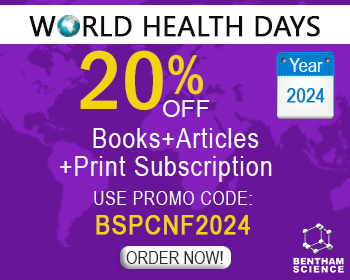摘要
背景:肌肉减少症的特征是由于衰老或慢性疾病(例如慢性肝病(CLD))而导致肌肉质量和力量的丧失(肌肉萎缩)。骨骼肌萎缩涉及不同的机制,包括减少肌肉纤维直径和肌球蛋白重链水平,增加泛素-蛋白酶体途径活性,氧化应激和肌核细胞凋亡。我们最近发现,除先前研究中未评估的肌核凋亡外,所有这些机制均与与肝毒素5-二乙氧基羰基-1,4-二氢可力丁(DDC)诱导的CLD相关的肌肉萎缩有关。 目的:在本研究中,我们使用补充DDC的饮食喂养小鼠模型评估了CLD相关肌减少症中肌核细胞凋亡的参与以及N-乙酰半胱氨酸(NAC)处理对肌肉力量和细胞凋亡的影响。 方法:在不使用或不使用NAC的情况下,对4个月大的C57BL6雄性小鼠进行标准饮食或DDC补充饮食六周。 结果:我们的结果表明,NAC减轻了补充DDC的饮食喂养小鼠腓肠肌(GA)肌肉中CLD诱导的肌肉消瘦相关的肌肉纤维直径和肌肉强度的降低。此外,与对照饮食喂养的小鼠的GA肌肉相比,DDC补充饮食诱导的CLD喂养的小鼠的GA肌肉表现出增加的肌核凋亡,这由凋亡核数,caspase-8和caspase-9的增加所证明。 caspase-3的表达,酶活性和BAX / BCL-2的比例。 NAC治疗抑制了GA肌肉中与肌核凋亡相关的所有机制。 结论:据我们所知,这是第一篇报道氧化还原调节CLD诱导的少肌症患者肌肉力量和肌核细胞凋亡的研究。
关键词: 肌肉减少症,慢性肝病,肝毒素,UPP氧化应激,细胞凋亡。
[http://dx.doi.org/10.1097/MOG.0000000000000261] [PMID: 26974417]
[http://dx.doi.org/10.1016/j.jhep.2016.07.040] [PMID: 27515775]
[http://dx.doi.org/10.1111/hepr.13000] [PMID: 29115721]
[http://dx.doi.org/10.1002/lt.24750] [PMID: 28240805]
[http://dx.doi.org/10.1097/TP.0000000000001232] [PMID: 27314169]
[http://dx.doi.org/10.1016/j.msec.2014.02.008] [PMID: 24656374]
[http://dx.doi.org/10.1016/j.abb.2018.12.009] [PMID: 30528779]
[http://dx.doi.org/10.1007/s00424-018-2167-3] [PMID: 29926227]
[http://dx.doi.org/10.1155/2018/2063179] [PMID: 29785242]
[http://dx.doi.org/10.1016/j.cellsig.2016.01.010] [PMID: 26825874]
[http://dx.doi.org/10.1152/ajpcell.00069.2010] [PMID: 20505039]
[http://dx.doi.org/10.1152/ajpcell.00125.2016] [PMID: 27510905]
[http://dx.doi.org/10.1016/j.dib.2016.03.009] [PMID: 27077080]
[http://dx.doi.org/10.1080/01926230701320337] [PMID: 17562483]
[http://dx.doi.org/10.1100/tsw.2010.27] [PMID: 20191247]
[http://dx.doi.org/10.1007/s00424-014-1617-9] [PMID: 25292283]
[http://dx.doi.org/10.1007/s12576-009-0049-3] [PMID: 19636670]
[http://dx.doi.org/10.1038/s41598-017-10673-8] [PMID: 28874733]
[http://dx.doi.org/10.1155/2014/616149] [PMID: 25197653]
[http://dx.doi.org/10.1016/B978-0-12-417158-9.00005-4] [PMID: 24974288]
[http://dx.doi.org/10.1155/2016/3458276] [PMID: 27833701]
[http://dx.doi.org/10.2147/CIA.S158513] [PMID: 29731617]
[http://dx.doi.org/10.1155/2018/6439138] [PMID: 29854088]
[http://dx.doi.org/10.1186/s13578-016-0103-9] [PMID: 27231526]
[http://dx.doi.org/10.1016/j.ejphar.2011.11.036] [PMID: 22173126]
[http://dx.doi.org/10.1016/S0014-5793(01)02316-X] [PMID: 11322939]
[http://dx.doi.org/10.1016/j.cmet.2014.12.001] [PMID: 25651175]
[http://dx.doi.org/10.1113/jphysiol.2007.148338] [PMID: 18258657]
[http://dx.doi.org/10.1016/j.jvs.2013.10.098] [PMID: 24388697]
[http://dx.doi.org/10.1155/2016/6842568] [PMID: 26798425]
[http://dx.doi.org/10.2353/ajpath.2007.061133] [PMID: 17600122]
[http://dx.doi.org/10.2147/IJN.S125521] [PMID: 28331320]
[http://dx.doi.org/10.1242/dmm.023390] [PMID: 26851244]
[http://dx.doi.org/10.1042/CS20140215] [PMID: 25222828]
[http://dx.doi.org/10.1155/2016/9047821] [PMID: 27579157]
[http://dx.doi.org/10.1152/ajpregu.00840.2010] [PMID: 21697520]
[http://dx.doi.org/10.1152/ajpcell.1997.273.2.C579] [PMID: 9277355]
[http://dx.doi.org/10.2165/00007256-200535060-00002] [PMID: 15974633]
[http://dx.doi.org/10.1159/000330064] [PMID: 21952604]
[http://dx.doi.org/10.1016/j.freeradbiomed.2007.05.028] [PMID: 18191752]
[http://dx.doi.org/10.1016/j.mad.2008.05.005] [PMID: 18579179]
[http://dx.doi.org/10.1038/s41374-018-0081-0] [PMID: 29925937]
[http://dx.doi.org/10.1164/rccm.200601-142OC] [PMID: 17082496]
[http://dx.doi.org/10.1093/jnen/59.5.398] [PMID: 10888370]
[PMID: 12121036]
[http://dx.doi.org/10.1186/s13395-017-0137-7] [PMID: 29047406]
[http://dx.doi.org/10.3748/wjg.v20.i23.7286] [PMID: 24966599]
[http://dx.doi.org/10.3390/ijms17050675] [PMID: 27164079]
[http://dx.doi.org/10.1097/MEG.0000000000001366] [PMID: 30920976]


























